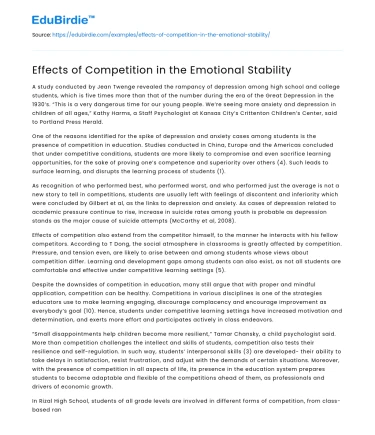A study conducted by Jean Twenge revealed the rampancy of depression among high school and college students, which is five times more than that of the number during the era of the Great Depression in the 1930’s. “This is a very dangerous time for our young people. We’re seeing more anxiety and depression in children of all ages,” Kathy Harms, a Staff Psychologist at Kansas City’s Crittenton Children’s Center, said to Portland Press Herald.
One of the reasons identified for the spike of depression and anxiety cases among students is the presence of competition in education. Studies conducted in China, Europe and the Americas concluded that under competitive conditions, students are more likely to compromise and even sacrifice learning opportunities, for the sake of proving one’s competence and superiority over others (4). Such leads to surface learning, and disrupts the learning process of students (1).
Save your time!
We can take care of your essay
- Proper editing and formatting
- Free revision, title page, and bibliography
- Flexible prices and money-back guarantee
As recognition of who performed best, who performed worst, and who performed just the average is not a new story to tell in competitions, students are usually left with feelings of discontent and inferiority which were concluded by Gilbert et al, as the links to depression and anxiety. As cases of depression related to academic pressure continue to rise, increase in suicide rates among youth is probable as depression stands as the major cause of suicide attempts (McCarthy et al, 2008).
Effects of competition also extend from the competitor himself, to the manner he interacts with his fellow competitors. According to T Dong, the social atmosphere in classrooms is greatly affected by competition. Pressure, and tension even, are likely to arise between and among students whose views about competition differ. Learning and development gaps among students can also exist, as not all students are comfortable and effective under competitive learning settings (5).
Despite the downsides of competition in education, many still argue that with proper and mindful application, competition can be healthy. Competitions in various disciplines is one of the strategies educators use to make learning engaging, discourage complacency and encourage improvement as everybody’s goal (10). Hence, students under competitive learning settings have increased motivation and determination, and exerts more effort and participates actively in class endeavors.
“Small disappointments help children become more resilient,” Tamar Chansky, a child psychologist said. More than competition challenges the intellect and skills of students, competition also tests their resilience and self-regulation. In such way, students’ interpersonal skills (3) are developed- their ability to take delays in satisfaction, resist frustration, and adjust with the demands of certain situations. Moreover, with the presence of competition in all aspects of life, its presence in the education system prepares students to become adaptable and flexible of the competitions ahead of them, as professionals and drivers of economic growth.
In Rizal High School, students of all grade levels are involved in different forms of competition, from class-based rankings to multi-level competitions held inside and outside of the school. Thus, it is important to address if competition provides a conducive learning environment for Rizalians, or disrupts their emotional health and learning capacities. The researchers have chosen this topic to promote effective and healthy learning environments for students, where they get to receive holistic development, towards being intellectual and emotionally healthy individuals.






 Stuck on your essay?
Stuck on your essay?

